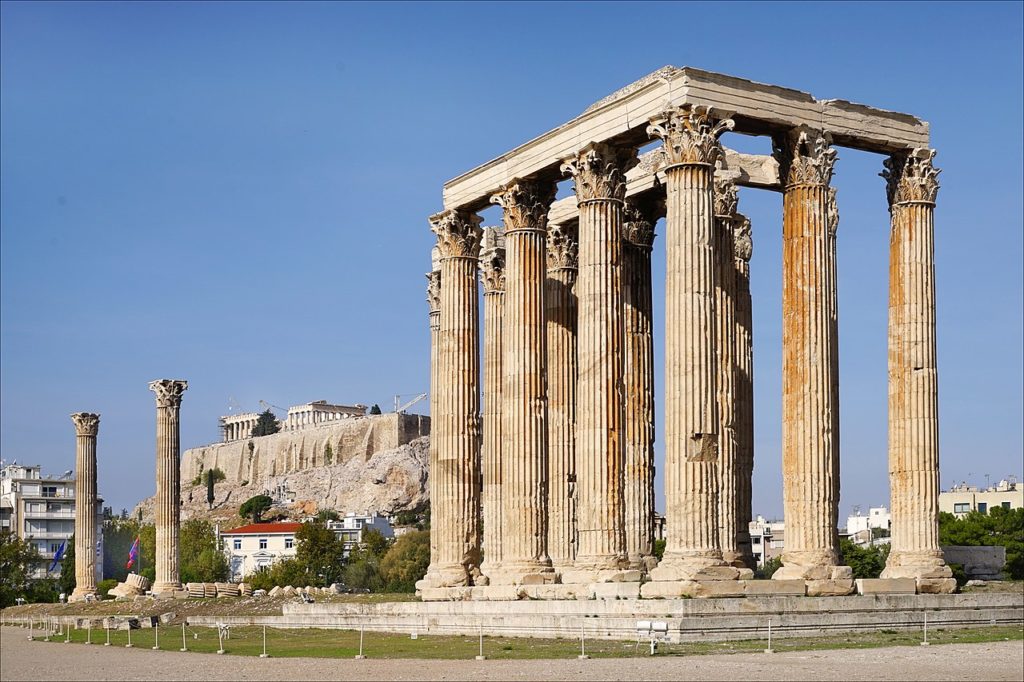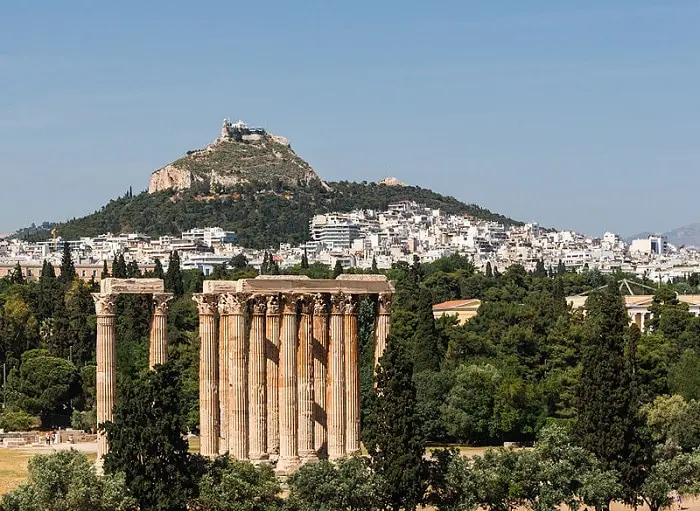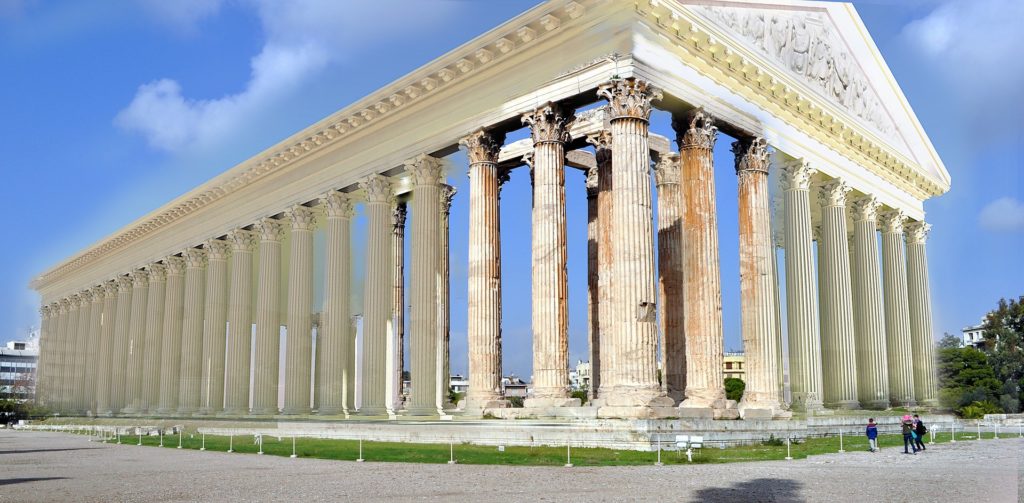
The Temple of Olympian Zeus lies at the heart of the Greek capital of Athens. It remains one of the most iconic landmarks of this historic city and an important center of the ancient Greek world.
The temple of Olympian Zeus was once amongst the largest temples in the ancient world. This monumental structure was, apparently, dedicated to Zeus, the king of the Olympian gods.
Its colossal size and imposing stature symbolized the wealth and power of ancient Athens. The temple’s colossal columns continue to dominate the Athenian landscape. This is despite the fact that most of the temple now lies in ruins. Whatever is left of it offers a glimpse into the religious faith and architectural ambition that defined Athens and ancient Greece as a whole.
The past of Athens’ grand temple

The origins of the Temple of Olympian Zeus go all the way back to the 6th century BC. The whole concept was initiated by the Athenian tyrant Pisistratus. Unfortunately, due to the fact that the sheer size of the construction was monumental, the temple’s completion would span several centuries. As a result, the involvement of various rulers led to the contribution of something different to the construction throughout the ages. This ambitious project saw a genuine and renewed interest under Hellenistic King Antiochus IV Epiphanes in the 2nd century BC.
Antiochus employed the Roman architect Cossutius to oversee its construction. He introduced innovative architectural techniques and decided that the temple would be constructed with the renowned Pentelic marble rather than limestone. He also chose to switch from the more austere Doric to the more extravagant Corinthian style. However, it was not until the reign of the famous Roman Emperor Hadrian in 131 AD that the temple was finally completed. This historic moment marked a significant point in the history of Athens, connecting its ancient past with its Roman legacy.
The construction of the temple of the Olympian Zeus became the living example of the changing dynamics and religious practices of both ancient Greece and Rome. It stood there, at the heart of a bustling religious precinct, surrounded by other sanctuaries and altars. Each one of them played its own unique role in Athens’ busy life. Nonetheless, this particular temple was not like any other. It was a monumental structure, embodying not only architectural innovations but also significant artistic achievements of the Greek and Roman times.
This is why the Temple of Olympian Zeus was proof of the changing fates of Athens throughout its history—from its Classical glory through the Roman period and into the early Christian era. The completion of the temple by Hadrian was celebrated with great fanfare. This became the cornerstone of the close ties between Classical Athens and the emerging Roman Empire. For the Romans, this temple became a symbol of imperial patronage but also of religious continuity.

Architectural wonders of the Olympian Zeus temple
Apparently, the Temple of Olympian Zeus became famous across the then-known world for its staggering dimensions and architectural splendor. It was truly a marvel of engineering and architectural ingenuity. Among the most striking features of the temple were the colossal Corinthian columns. Each one of them stood at a staggering height of about 17 meters (56 feet). Because of Antiochus’ decision, they were all crafted from Pentelic marble, which always shines under the beautiful Athenian sun.
Originally, the temple had a total of 104 columns. Unfortunately, only 15 remain standing today, with an additional column lying on the ground. It is still in the spot where it fell during a storm in 1852. These columns remain emblematic of the Corinthian elegance and truly represent the zenith of Greek architectural expertise.
The layout of the temple was no different than the traditional one of many other Greek temples. It had a rectangular cella, which was surrounded by columns. However, it was its size that made it anything but ordinary.
It measured approximately 96 meters (315 feet) in length and 40 meters (131 feet) in width. This made it one of the largest temples ever constructed in the ancient world. The temple incorporated architectural advancements of the Hellenistic and Roman periods and reflected the ambition of Athens to create a religious monument that would celebrate Zeus as the supreme god of the Greek pantheon.
Adjacent to the temple were numerous other structures, including altars, smaller temples, and statues. All together they formed a proper religious unit, honoring the god of the gods. The Athenians of the time would gather there to worship Zeus and participate in various festivals of the Olympieion, as the temple precinct was known as a whole.

The rise, fall, and restoration of Athens’ ancient marvel
Sadly, the decline of the Temple of Olympian Zeus began in the late antiquity period. As Christianity started to replace the ancient Greek religion, the temple lost its previous prestige. Most of the large spaces of the temple, as well as its surroundings, were repurposed. Many parts of the construction were, unfortunately, dismantled.
They were then used in the construction of other buildings, particularly during the Byzantine era. As time went by and Athens lost its prestigious stature in the world, the temple suffered from neglect. On top of that, earthquakes and looting led to the loss of many of its columns as well as the deterioration of the structure itself.
In the Middle Ages, when Athens was not the important hub that it used to be, the area around the temple was largely abandoned. It was quite literally turned into grazing land for the livestock of the locals. It wasn’t until the 19th century that interest in the temple was rekindled once again. This was spurred by the Greek War of Independence and the establishment of the modern Greek state. Archaeological interest in the site grew worldwide. This, thankfully, led to efforts to document and preserve what had remained from this once-colossal monument.
The temple of Olympian Zeus as a modern attraction
Modern preservation efforts have mainly focused on stabilizing and restoring what is left of the temple. Despite the various challenges, these efforts have helped the Temple of Olympian Zeus remain a prominent landmark in Athens to this day. It stands as a poignant reminder of the city’s ancient splendor and continues to attract tourists from around the world who hope to experience this great ancient city. The preservation of the temple also serves an educational purpose for many archaeologists. It offers insights into the architectural techniques of the ancient Greeks and Romans, as well as the religious and cultural practices of the time.
From its inception in the 6th century BC to its role as a modern tourist attraction, the Temple of Olympian Zeus has gone through a remarkable historical journey. Despite its decline and destruction, it remains a pure symbol of Greece’s great past.
Recently, the temple started to get a makeover in what is seen as the single most difficult and important maintenance project in recent years in the Greek capital. The aim of the restoration project, carried out by the Ephorate of Antiquities of Athens, is to proceed with consistent maintenance work on the monument, as it has suffered serious damage over the centuries.
See all the latest news from Greece and the world at Greekreporter.com. Contact our newsroom to report an update or send your story, photos and videos. Follow GR on Google News and subscribe here to our daily email!



